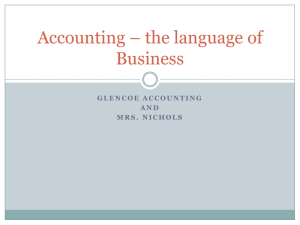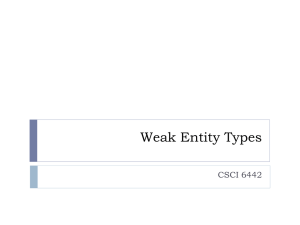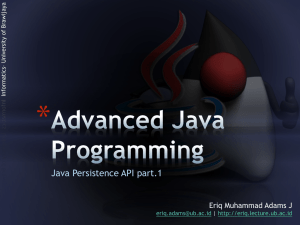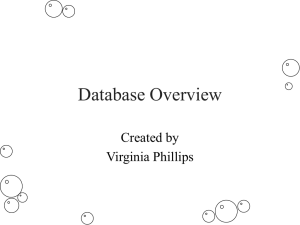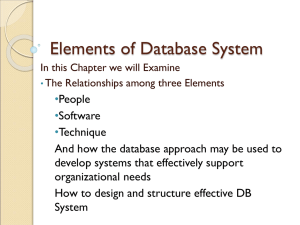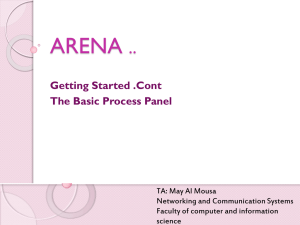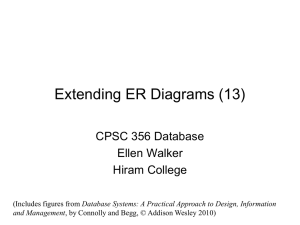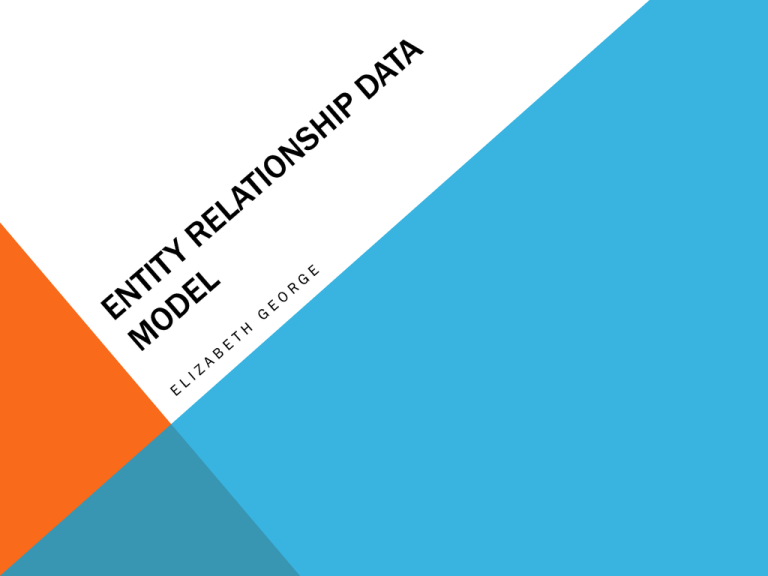
INTRODUCTION
• Architect
• Aeronautical engineers
• Computer architects
• Traffic engineers
DATA MODEL
Data Model is made to transform the client
requirements into specifications which are then given
to the database builder
BENEFITS OF DATA MODELING
• Focusing on essentials
• Ease of communication and understanding
• Product or process improvement
• Exploring alternatives
TYPES OF MODELS
• Descriptive
• Prescriptive
• Representative
PHASES OF DATABASE MODELING
• Conceptual modeling
• Logical design phase
• Implementation
AN EXAMPLE: COMPANY DATABASE
•
•
•
•
•
The company database keeps track of a company’s employees, departments, and
projects.
The company is organized into departments. Each department has a unique name, a
unique number, and a particular employee who manages the department. We keep
track of the start date when that employee began managing the department. A
department may have several locations.
A department controls a number of projects, each of which has a unique name, a
unique number and a single location
We store each employee’s name, social security number, address, salary, sex, and
birth date. An employee is assigned to one department, but may work on several
projects, which are not necessarily controlled by the same department. We keep track
of the number of hours per week that an employee works on each project. We also
keep track of the direct supervisor of each employee.
We want to keep track of the dependents of each employee for insurance purposes.
We keep each dependent’s first name, sex, birth date , and relationship to the
employee.
ENTITIES AND ENTITY SETS
• Entity is a real or abstract object that can be distinctly
identified and is of interest.
• The part of and enterprise that is of interest is called
the Universe of Discourse (UoD)
• An entity set is a set of objects called entity instances
or entity occurrences
• An entity set is an individual object of a given entity
type
RELATIONSHIPS, CARDINALITY, ATTRIBUTES
• A relationship is an association among entities.
• Cardinality Ratio of a relationship: It is the maximum
number of relationship instances that an entity can
participate in.
• Information about entities which are of interest are
called attributes.
ATTRIBUTES
The description of each entity instance in an entity set
and the information of interest is called entity
attributes
10
TYPES OF ATTRIBUTE
Simple or Composite
Single or Multi-valued
Stored or Derived
Required or Optional
Null attributes
11
ENTITY KEY, CANDIDATE KEY AND
SUPER KEY
A group of attributes (possibly one) used for identifying
each entity in an entity set is called an entity key
Primary key – is an attribute or a set of attributes that
uniquely identifies a specific instance of an entity.
Every entity in an ER model must have a primary key
12
CANDIDATE KEY
When an entity has more than one attribute (or a set of
attributes) that can serve as a primary key, each of
such keys is called a candidate key.
One and only one of the candidate keys is chosen as
the primary key for the entity
13
WEAK ENTITY
Weak entity – an entity that depends on another entity
for identification
Weak entity relation – a relation that is used for
identifying entities
Regular entity relation – a relation not used for
identifying entities
14
NAMING CONVENTIONS:
ENTITIES
1. Each entity name should come from the entity
description
2. Each entity name should be a noun
3. The first letter should be a uppercase
4. Underscores should join the words
5. Names of the entities should be meaningful and
should not conflict with other entity names
15
NAMING CONVENTIONS:
RELATIONSHIPS
1. Each relationship name should be a verb that fits the
sentence structure
2. Can use underscores to join the words
16
CROW’S FOOT DIAGRAMMATIC
NOTATION
1:1 relation
Employee
Attributes
Office
Attributes
17
MANY TO ONE .. ETC…
n:1
relation
Employee
Attributes
Office
Attributes
18
CARDINALITY RATIOS
•
One – to – One
•
One – to – Many
•
Many – to – Many
19
WEAK ENTITY TYPES
A weak entity is also called a subordinate entity since its
existence depends on another entity. This is called
existence dependence.
The primary key of a weak entity is found by taking the
primary key of the strong entity on which it is
existence dependent combined with the discriminator
of the weak entity set.
WEAK ENTITY SETS (CONT.)
We depict a weak entity set by double rectangles.
We underline the discriminator of a weak entity set with a dashed line.
payment_number – discriminator of the payment entity set
Primary key for payment – (loan_number, payment_number)
GENERALIZATION, SPECIALIZATION
AND AGGREGATION
“is a” relation
For example: Car “is a” vehicle
An entity cannot exist in a database which merely
belongs to subclass, it should also belong to the super
class
The characteristics of car apply to all the vehicle
If a general class entity participates in a particular
relationship type, then the specialized class entity
should also participate in that relation
22
SPECIALIZATION
The Process of creating a subclass out of a given entity
type is called specialization
Ford Figo “is a” car “is a” vehicle
The reverse process of taking 2 or more entity types and
clubbing them under a common super class is called
generalization
23
AGGREGATION
Aggregates a particular ER schema and makes it into an
entity at higher level of abstraction
“contains”
Offering “contains” offer
Mostly used for Knowledge Management like ontology
process
24
Aggregation
n Consider the ternary relationship works-on, which we
saw earlier
n Suppose we want to record managers for tasks
performed by an
employee at a branch
25
E-R Diagram With Aggregation
26
27
28
TYPES OF GENERALIZATION AND
SPECIALIZATION
Disjoint
Overlapping
Union
29
30
31
32
SPECIALIZATION
Is the process of defining a set of subclasses of a
superclass
The set of subclasses is based upon some distinguishing
characteristics of the entities in the superclass
Example: {SECRETARY, ENGINEER, TECHNICIAN} is a
specialization of EMPLOYEE based upon job type.
May have several specializations of the same superclass
33
EXAMPLE OF A SPECIALIZATION
34
GENERALIZATION
The reverse of the specialization process
Several classes with common features are generalized
into a superclass; original classes become its
subclasses
Example: CAR, TRUCK generalized into VEHICLE; both
CAR, TRUCK become subclasses of the superclass
VEHICLE.
We can view {CAR, TRUCK} as a specialization of VEHICLE
Alternatively, we can view VEHICLE as a generalization of CAR and
TRUCK
35
UNION TYPE
Example: Database for vehicle registration, vehicle owner can be a
person, a bank (holding a lien on a vehicle) or a company.
Category (subclass) OWNER is a subset of the union of the three
superclasses COMPANY, BANK, and PERSON
A category member must exist in at least one of its superclasses
Note: The difference from shared subclass, which is subset of the
intersection of its superclasses (shared subclass member must
exist in all of its superclasses).
36
EXAMPLE OF CATEGORIES
(UNION TYPES)
37
SELF STUDY
ER diagram conventions/ notations
Strengths and Weakness of ER Diagram
The database design process (step by step)
i.
Requirement analysis
ii.
Identify entity sets
iii.
Identify relationship sets
iv.
ER diagram
v.
Value sets and attributes
vi.
Primary keys
vii. Prototype
viii. Implementation
38
REFERENCES
Database Management Systems, G.K. Gupta
www.nptel.ac.in
39
THANK YOU!
40


